Related Research Articles

John Rosamond Johnson was an American composer and singer during the Harlem Renaissance. Born in Jacksonville, Florida, he had much of his career in New York City. Johnson is noted as the composer of the tune for the hymn "Lift Every Voice and Sing". It was first performed live by 500 Black American students from the segregated Florida Baptist Academy, Jacksonville, Florida, in 1900. The song was published by Joseph W. Stern & Co., Manhattan, New York.

The Knickerbocker Theatre, previously known as Abbey's Theatre and Henry Abbey's Theatre, was a Broadway theatre located at 1396 Broadway in New York City. It operated from 1893 to 1930. In 1906, the theatre introduced the first moving electrical sign on Broadway to advertise its productions.

Niblo's Garden was a theater on Broadway and Crosby Street, near Prince Street, in SoHo, Manhattan, New York City. It was established in 1823 as "Columbia Garden" which in 1828 gained the name of the Sans Souci and was later the property of the coffeehouse proprietor and caterer William Niblo. The large theater that evolved in several stages, occupying more and more of the pleasure ground, was twice burned and rebuilt. On September 12, 1866, Niblo's saw the premiere of The Black Crook, considered to be the first piece of musical theater that conforms to the modern notion of a "book musical".
Henry Martyn Blossom Jr. was an American writer, playwright, novelist, opera librettist, and lyricist. He first gained wide attention for his second novel, Checkers: A Hard Luck Story (1896), which was successfully adapted by Blossom into a 1903 Broadway play, Checkers. It was Blossom's first stage work and his first critical success in the theatre. The play in turn was adapted by others creatives into two silent films, one in 1913 and the other in 1919, and the play was the basis for the 1920 Broadway musical Honey Girl. Checkers was soon followed by Blossom's first critical success as a lyricist, the comic opera The Yankee Consul (1903), on which he collaborated with fellow Saint Louis resident and composer Alfred G. Robyn. This work was also adapted into a silent film in 1921. He later collaborated with Robyn again; writing the book and lyrics for their 1912 musical All for the Ladies.

The Hudson Theatre is a Broadway theater at 139–141 West 44th Street, between Seventh Avenue and Sixth Avenue, in the Theater District of Midtown Manhattan in New York City. One of the oldest surviving Broadway venues, the Hudson was built from 1902 to 1903. The exterior was designed by J. B. McElfatrick & Son, while Israels & Harder oversaw the completion of the interior. The theater has 970 seats across three levels. Both its exterior and interior are New York City designated landmarks, and the theater is on the National Register of Historic Places.
The Fifth Avenue Theatre was a Broadway theatre in Manhattan, New York City, United States, at 31 West 28th Street and Broadway. It was demolished in 1939.
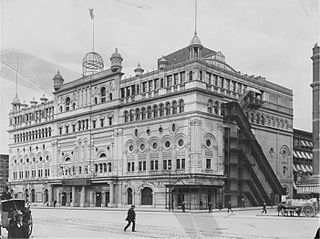
The Olympia Theatre, also known as Hammerstein's Olympia and later the Lyric Theatre and the New York Theatre, was a theatre complex built by impresario Oscar Hammerstein I in Longacre Square, New York City, opening in 1895.

Joseph Morris Weber was an American vaudeville performer who, along with Lew Fields, formed the comedy double-act of Weber and Fields.

Louis Mann was an American theatre actor and sometime director, who in his later life made a few appearances in motion pictures. He was married to actress and playwright Clara Lipman.

The Herald Square Theatre was a Broadway theatre in Manhattan, New York City, built in 1883 and closed in 1914. The site is now a highrise designed by H. Craig Severance.
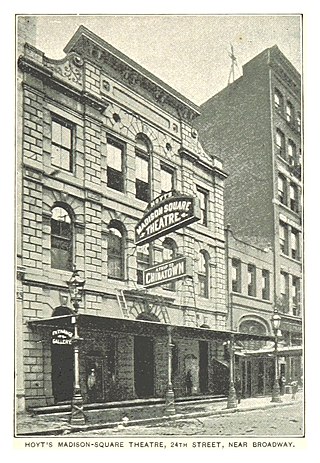
The Madison Square Theatre was a Broadway theatre in Manhattan, on the south side of 24th Street between Sixth Avenue and Broadway. It was built in 1863, operated as a theater from 1865 to 1908, and demolished in 1908 to make way for an office building. The Madison Square Theatre was the scene of important developments in stage technology, theatre design, and theatrical tour management. For about half its history it had other names including the Fifth Avenue Theatre, Daly's Fifth Avenue Theatre, Hoyt's Madison Square Theatre, and Hoyt's Theatre.
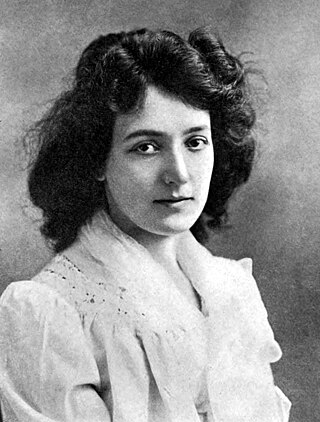
Clara Lipman was an American musical comedy actress and playwright whose career began in 1885 and continued on until her retirement in 1927. She was the wife of comedian Louis Mann and the sister of popular Lieder singer Mattie Lipman Marum.
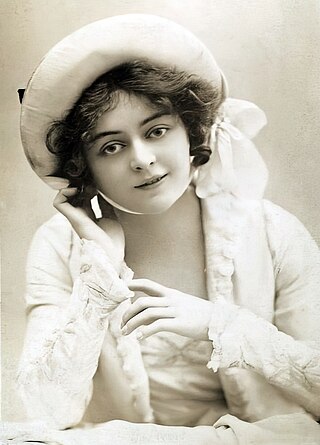
Adrienne Adele Augarde was an English actress and singer popular for nearly a decade on both sides of the Atlantic Ocean, primarily for her roles in Edwardian musical comedy.

The Anco Cinema was a former Broadway theatre turned cinema at 254 West 42nd Street, between 7th and 8th Avenues in Manhattan, New York City. It opened in 1904 and was originally named the Lew Fields Theatre. It continued to operate as a playhouse under various names until it was converted into a movie theatre in 1930. Its block was famous for its concentration of Broadway theatres turned cinemas. After World War II, the street declined and the Anco Cinema eventually became a pornography venue. It closed as a cinema in 1988 and was gutted for retail use. The building was demolished in 1997.

Daly's Theatre was a Broadway theatre at 1221 Broadway and 30th Street. It was built in 1867 and opened that year as Banvard's Museum but changed its name the following year to Wood's Museum and Metropolitan. In 1876 it became the Broadway Theatre, and finally was named Daly's Theatre in 1879 when it was acquired by Augustin Daly. After 1899, it was operated by the Shubert family. The building was demolished in 1920, after serving as a burlesque theatre and cinema.

Lotta Linthicum was an American actress on Broadway.
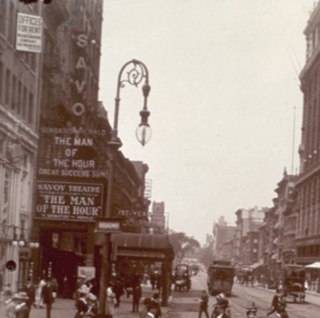
The Savoy Theatre was a Broadway theatre at 112 West 34th Street in Midtown Manhattan, New York City. It opened in 1900. It was converted to a cinema around 1910, until it was closed in early 1952 and then demolished.

The Bijou Theatre was a former Broadway theater in New York City that opened in 1878 as Theatre Brighton and was demolished in 1915. It also served as an opera house and silent movie venue throughout its history. Located at 1239 Broadway between 30th and 31st Streets, had been converted from a drinking and gambling establishment into a theatre for variety, and opened August 26, 1878, with Jerry Thomas as proprietor. The house had many changes and names until John A. McCaull, a Baltimore lawyer, and Charles E. Ford took charge of it. Considerable money was spent and when they reopened the house on March 31, 1880, as the Bijou Opera-house, it looked like a modern and well-regulated theatre. In 1881 and 1882, Lillian Russell appeared in three different operettas.
Lee Orean Smith was an American composer, arranger, music editor, publisher, music teacher, multi-instrumentalist, and conductor. A diverse composer who began his career writing Tin Pan Alley songs and music for the theatre, he later had a prolific output of published band and orchestral works; both arrangements and original pieces. He published music not only under his own name, but also under numerous pseudonyms, including Calvin Grooms, Maurice Lee, Leon Obrero, José Santos, Leopold Lamont, and François Chevalier. Smith composed music for multiple works staged on Broadway, and was the longtime managing editor of the band and orchestra department in the music publishing firm of Leo Feist. At the time of his death he was an editor for Carl Fischer Music.
Weber and Fields' Broadway Music Hall, sometimes simplified to Weber and Fields' Music Hall, was a Broadway theatre located in Manhattan on 29th Street near the corner of 29th and Broadway going towards Sixth Avenue. It was the resident theatre of comedy duo Joe Weber and Lew Fields from 1896 through 1904; with the pair starring in numerous original high energy musical farces mounted at that theatre.
References
- ↑ Brown, Thomas Allston A History of the New York Stage, Vol. 3. Dodd, Mead and Company; New York; 1903:579
- ↑ "Fire Closes American; 1 Wheel Show Folds". Variety: 37. December 24, 1930 – via Media History Digital Library.
- ↑ "American Music Hall". Internet Broadway Database.
- ↑ "DRAMATIC AND MUSICAL; Mrs. Fiske as "Frou-Frou" and a New Casino Play. LA GIOCONDA" IN ENGLISH Last of the Wagner Cycles -- Various Changes of Bill -- Music Hall "Turns."". The New York Times . March 21, 1899. p. 7.
- ↑ "Notes on Plays; "Checkers" Something New in Melodrama at the American Theatre". The New York Times . October 1, 1903. p. 5.
- ↑ Reeder, Thomas. "'The L-Ko Komedy Kompany': Lehrman's Baby". Mr. Suicide: Henry Pathé Lehrman and The Birth of Silent. Bear Manor Media. ISBN 978-1629331621.